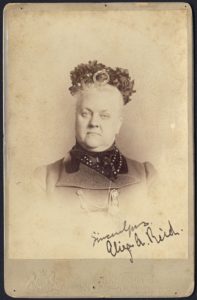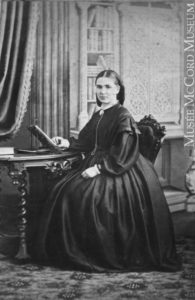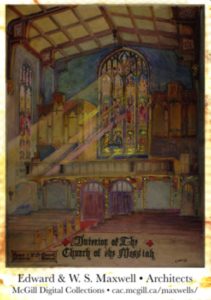
Eliza Anne McIntosh Reid (October 30, 1841-January 8, 1926) was a social reformer, women’s activist, and a leader in the movement to gain access to higher education for Canadian women. A life long Unitarian, her contributions would be continued and expanded by her daughter, Helen R. Y. Reid.
One of nine children, three sons and six daughters, Eliza was born in Montreal, Quebec, Canada to Margaret (nee Brown) and Nicholas McIntosh. Her father was a prosperous cabinet maker at a time when the Scottish immigrant community dominated commerce in Montreal. One of Eliza’s sisters studied with private teachers and attended lectures of the Montreal Ladies Educational Association. It is likely that Eliza’s schooling was similar, especially judging from her later involvement and interest in education for women. She also had a musical education because she could read music, sang in the church choir and played the organ for church services.
Eliza Ann McIntosh was baptized at the Saint Gabriel Street Scotch Presbyterian church in 1842. Later that year the Montreal Unitarian Society was formally organized, a first in British North America. A minister, John Cordner, was called the following year and a church building was finished in 1845. Cordner had just finished his training as a non-subscribing Presbyterian in Ulster (Northern) Ireland. The McIntosh family switched to the Unitarian congregation and Eliza was baptized a second time by Cordner. She attended the Unitarian Sunday School and later taught in it. There is a record from 1857 of her father donating five pounds as the first installment of his building fund subscription. The old Montréal Unitarian Church was replaced that same year and the new building was named the Church of the Messiah.
Eliza was married to Robert Reid on September 12, 1867 in the Church of the Messiah by John Cordner. Her husband, born and educated in Scotland, was proprietor of the Montreal Sculpture and General Marble and Granite Works. He came to Canada to work with his uncle, James Mavor who had headed the firm. Clearly prosperous, both families lived in Montreal’s fashionable St. Antoine Ward (also known as “uptown” and later as The Square Mile). The Reid and McIntosh families lived a few door apart, both had servants, and both attended the Unitarian Church. Robert, who listed his occupation as a sculptor, was an artist as well as a businessman. He designed and built statues and monuments in the United States and Canada. By 1912 the business was popularly known as the Robert R. Marble Works.
There are varying reports about the number of children in the Reid family. Census records seem to indicate four children; Robert Hudson born September 1, 1868; Helen Richmond born December 11, 1869; Ethel, born in 1874; and Edith, born July 10, 1878.
In 1884 when recent women graduates of the Montreal School for Girls met at Eliza’s house, to talk about their future, Eliza was described as an intelligent and supportive woman. The graduates decided to apply for admittance to McGill University, at that time a male-only institution. Reid’s daughter Helen was one of two women delegated to meet with the principal. McGill agreed to accept women but it was not implemented until later that year after Donald Alexander Smith (ennobled Lord Strathcona in 1897) donated fifty thousand dollars to offset the additional expense of separate facilities and classes for women and men. According to one record, it was Reid who encouraged Donald Alexander Smith’s donation. Her daughter Helen was in the first class of women to enter the university.
According to Reid’s daughter Helen, “So much of her life was lived for the church and so much of the inspiration of her many outside good works had its source in the church and in the life of the free spirit for which it stands.” Sixty-six years of that work took place during two long and successful Montreal ministries; John Cordner, 1843-1878; and William Sullivan Barnes, 1879-1909. After the Cordners’ moved to Boston in 1879, Reid corresponded with Mrs. Cordner until her death in 1908. When William Sullivan Barnes retired, Reid recommended him for a McGill University honorary degree.
Reid was a director of the Montreal Unitarian Church’s Unity Club that in 1890 succeeded the Liberal Christian Union. For many years the Unity Club met every first and third Wednesday evening for lectures and music. She was founder in 1898 of the Young Peoples’ Alliance of the church. According to her daughter, she “…tried to help the boys and girls to think reverently about church and religious things…” Some meetings were held at her house.
When a troop of Montreal scouts was established in 1911 she contributed to the purchase of equipment and books. In 1917, she gave them a stand of King’s and troop colors made in England. When the scouts passed her house, they would salute her.
The 1846 constitution of the Montreal Unitarian Society said “.. . it shall be competent to females to attend all meetings of this congregation and to exercise the same privileges as members of this Society as are exercised by males.” But it wasn’t until 1909 that a woman would serve on the Church of the Messiah Board of Management in more than an advisory role. Reid was one of the first women to so serve.

Montreal had been the capital of Canada until 1849 when the government was moved to Ottawa. In the nineteenth-century, Montreal was an important urban center in the British Empire; it was the largest city in Canada, a center for trade, and the country’s financial and cultural capital. Betweem 1880 and 1900, the population of Montreal nearly doubled.
Except for the entry of women into McGill, Reid is not documented until 1892 when she founded the Montreal Women’s Club, one of the first women’s organizations in Canada. She was inspired by similar organizations in a number of American cities (Sorosis and Federation of Women’s Clubs). Reid served as the first president and continued as president for ten years until she resigned in 1902. The club’s objectives were to promote the cultural, scientific and social development of its members. A feminist orientation clearly colored its activities including concern for the lack of women on school and hospital boards and on university faculties. The club sent petitions to government and other authorities and organized lectures on education, law, women and work, and women’s legal status.
When the local Council of Women (The Montreal branch of National Council of Women of Canada) was founded in 1893, the earlier Montreal Women’s Club affiliated with this new federation of women’s groups. Reid became Vice President of the local Council of Women at its inception and continued to serve on its board into the mid-1920s. She also chaired its legislative committee.
Many of the leaders of the Women’s Club and the Council of Women including Reid were from Montreal’s well-to-do families. Many lived in the posh neighbourhood called uptown (The Square Mile). This cosmopolitan group—with both Anglophone and French Canadian women—included Catholic, Orthodox Jewish, Protestant, and Unitarian women. Honouring this diversity, club meetings began with a silent prayer.
A biography of Reid in Henry James Morgan’s 1912 publication, Canadian Men and Women of the Time, calls her a “founder and organizer Woman’s Work.” She is listed as a believer in Free trade, Liberal Government, and public schools. She favored civic control of public utilities and she felt it was the duty of women to exercise their privilege of voting and “generally to fit themselves to be good citizens.”
Reid was active in a number of other charitable and educational projects. She was active in the Montreal Parks and Playgrounds Association, the Charity Organization Society, the Women’s Protective Immigration Society, the Victorian Order of Nurses and the press committee for the Council of Women. In 1915, when a McGill Law School graduate wasn’t allowed to take the bar examination because she was a woman, Reid was quoted in a newspaper calling the ruling “Narrow minded.”

Reid and her husband were very active in the construction of a new Church of the Messiah building on Sherbrooke and Simpson Streets. It was designed by Edward & W. S. Maxwell. From 1904 to 1912, Eliza raised money in various ways. Her daughter said that, “Through all these years my mother had been working, not only with her heart and mind and giving richly of her time and strength for her beloved church, but her hands too were constantly busy with pen and paper, yes, but also with needle and thread, with pretty silks and wools, beads, …and knitting and crochet.” In 1905 Reid earned over one thousand dollars for the church.
Her greatest and most difficult work for the church, wrote her daughter, was organizing and raising money for the William Sullivan Barnes memorial window. Reid solicited funds from all over the world. It was installed in the new building which Barnes had worked so hard to build. The building opened in 1908 and Barnes retired the following year.
Reid’s husband died in 1919. She was seventy-seven years old in 1921 and she was still living in the family home at 698 Sherbrooke Street. The census lists her as an invalid. Her daughters Helen and Edith, both single were living with her. Both had shaved a few years off of their age for the census (3 years for Helen, 8 for Edith). Eliza McIntosh Reid died in 1926. The Reid Room in the Church of the Messiah was later dedicated to the memory of Eliza Reid and her daughter Helen R. Y. Reid. The Church of the Messiah, including the Barnes window, was destroyed by fire in 1987.
Sources
Papers about Reid are held in the Montreal Unitarian Church Archives and in the collections of the McCord Museum of Canadian History. Both are located in Montreal, Quebec, Canada. Eliza Reid is covered in Virginia Martin, “Give Us Courage: the Contributions of Helen Richmond Young Reid,” in Invisible Influence: Claiming Canadian Unitarian Universalist Women’s History (2011). The Montreal Church archive holds a typewritten manuscript by Helen Richmond Young Reid, My Mother Mrs. Robert Reid: Some notes on her life in and for the Church of the Messiah (1926). A useful biography of Reid, written by Louise Bienvenue, in the Dictionary of Canadian Biography can be accessed on the internet at biographi.ca. An early biography is in Henry James Morgan, ed., The Canadian men and women of the time: a handbook of Canadian biography of living characters (1912).
More on the Montreal Church of the Messiah can be found in Charles Eddis, “The Story of A Sacred Space: From Creation to Ruin” (1992), a paper delivered to the Canadian Unitarian and Universalist Historical Society. An extended history of Unitarianism in Montreal is found in Phillip Hewett, Unitarians in Canada (1995). For more on women and McGill University see Margaret Gillett, We walked very warily: A history of women at McGill (1981). Also useful is the unpublished manuscript by Nevil Norton Evans, History of the Church of the Messiah Second Half-Century (1942). Montreal women’s clubs and Reid’s role in them is covered in Elizabeth Kirkland, Mothering Citizens: Elite Women in Montreal 1890-1914 (2011). For more on Montreal’s Scottish community see Robert Campbell, A History of the Scotch Presbyterian Church, St. Gabriel Street, Montreal (1887) and Heather McNabb, Montreal’s Scottish Community, 1835-65 (1999). Census data can be accessed at the Library and Archives of Canada (bac-lac.gc.ca).
The sculpture “Silence” (1875), by her husband Robert Reid is in the Laurel Grove Cemetery in Savannah, Georgia. A second figure, “Judgment,” (1875) is in the Laurel Hill Cemetery in Thomasville, Georgia. The Canadian Volunteer Monument on Queen’s Park Crescent in Toronto, Ontario is one of many monuments by Robert Reid in Canada.
Article by Virginia Martin
Posted October 13, 2016